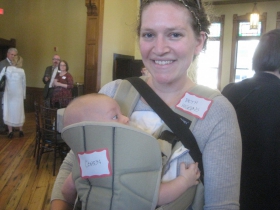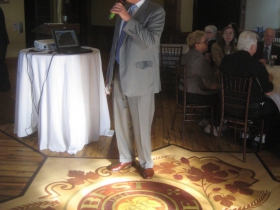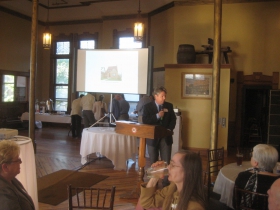Celebrating the Life of Paul Jakubovich
A host of notables gathered to salute Jakubovich and the fabulous historic architecture of Milwaukee he helped protect.
The gathering last week to honor the life of the late Paul Jakubovich had many memorable anecdotes, but let us begin with Ald. Bob Bauman, who told a story that put Milwaukee’s historic preservation status in context. “Milwaukee had a growth spurt in the late nineteenth century to the 1920’s,” he told an audience at the Great Hall at Best Place at the Historic Pabst Brewery. “We were the Silicon Valley of the era.” Great wealth was created here, and some of it remains in the buildings and mansions of the early entrepreneurs.
The downtown alderman said he is continually amazed by visitors to Milwaukee who are awed by the city’s great old buildings. Many of us remember fine structures now gone due to misguided “renewal” and freeway construction, and don’t realize how much we have left, he noted. We fail to recognize that we are surrounded by more history than residents of far older cities.
That’s why it is in the city’s interest to have a strong historic preservation officer who “would not be an adversary, but here to make your property better and the city more valuable,” by keeping the old buildings alive, Bauman said. Such an officer would “have the ability to work with the largest developers as well as the most humble homeowners trying to build a garage.”
Keynote remarks were made by H. Russell Zimmerman, author of several seminal works on Milwaukee architecture including the Heritage Guidebook (Landmarks and Historic Sites in Southeast Wisconsin [1976], and Magnificent Milwaukee: Architectural Treasures 1850-1920 [1987]. Zimmerman said that a young Jakubovich helped him at a critical time to pull his research together, and that the two remained lifelong friends.
“In the 1960s, we tore down 30 percent of the best buildings in the city,” Zimmerman said. This was a catalyst for the city’s preservation movement and for Jakubovich’s career in preserving whatever could be saved of Milwaukee’s historic fabric.
“I don’t want to use the word fanatical –” Zimmerman said, without finishing the sentence, as the audience laughed approvingly. Yes, Jakubovich was a little bit obsessed with his mission in his own quiet, but firm way.
“He didn’t raise his voice. But he stood his ground,” Zimmerman concluded.
After acknowledging Carlen Hatala, “a remarkable researcher, an excellent writer,” who worked with Jakubovich in the preservation office, Bauman introduced Jim Haertel, the owner of the hall where the event was being held.
The Great Hall, built in 1880, includes the corner office of Fred Pabst. When Haertel bought the building in 2001, the room was a mess, filled with junk, and greatly neglected, seemingly since the day Pabst died in 1904.
The place has now been very sensitively restored to its historic roots. After great anguish, the color “Muted Gold” was chosen for the walls. That was appropriate, said Haertel, since Jakubovich was not a preservationist to gild a lilly. Authenticity ruled with him. A display in the room showed three renderings of period-appropriate garages drawn by Jakubovich, suitable for homes from the early period (say, 1870’s) to the Queen Anne (1880-1900) to the Craftsman era (say to about 1920).
Haertel told of his own experiences dealing with Jakubovich to tweak each little detail in the restoration. Certain details would have to be just so — although there were exceptions. Jakubovich allowed a giant, way-out-of-scale light fixture to illuminate Captain Pabst’s office, since the original was long lost. “It is so large that no architect in the future would think it to be an original item,” Haertel said by way of explanation. Preservationists have humor, too.
“We’re fighting the good fight here,” he said, mentioning an earlier plan called Pabst City that would have created an “entertainment destination” that would have wiped out most of the brewery’s buildings, including his.
“I’m only here because of people like Paul Jakubovich,” Haertel said. “Paul is an example for us all. His passion started as a youth when he saw a church torn down. … He’s not gone. He’s all around us.”
Haertel also mentioned Jakubovich’s devotion to his mother, Anna Jakubovich, an elegant woman who was present in the room and acknowledged the audience’s applause during the tribute to her son.
Also speaking was Mike Mervis, a spokesman for the Zilber Group, developers of Best Place, and a close colleague of company founder Joe Zilber. Mervis attended with his wife, Mary Ellen Mervis.
“Jakubovich wanted to save everything at the old brewery, and Joe Zilber wanted to save what could be saved. It was the right answer,” Mervis said.
“We used lots of Paul’s vision and lots and lots of Joe Zilber’s money,” he added, to the laughter of those in attendance.
“He was a strong advocate, and a formidable adversary. The bar that Paul set has not and will not be lowered.”
Mervis then announced that a new park would be created across the street from the Great Hall.
“It will have two unique features,” he said. “One — a Pabst Brewing Company History, and Two — A yet-unstructured honor to Paul and his life and his work.”
A final tribute was made by Jim Owczarski, the City Clerk. Legislation sponsored by Kovac, Bauman, and Tony Zielinski, aldermen with large swaths of historic buildings in their districts, transferred the historic preservation office from the Department of City Development to the city clerk, where it was felt to be more insulated from political pressure.
Owczarski said he had heard rumors that his new charge would be difficult to control. “He yells, he screams!” Owczarski was told. “I was warned that Jakubovich would be a wild man!” So the clerk made a point to watch his new employee in action.
“I’m watching you!” Owczarski told him.
Of course, Jakubovich didn’t yell, he didn’t scream, and he wasn’t wild. Rather, the preservation officer, always in his suit and tie, would present his case calmly and firmly, and backed by astounding technical knowledge.
If somebody on Lake Drive wanted to put a Renaissance Revival window in an Elizabethan Tudor, Jakubovich would show them the error of their ways, and would withhold a Certificate of Appropriateness until the proper fenestration was arranged. In the long run, it was apparent from the audience’s response, the extra time and extra expense it cost to meet Jakubovich’s specifications, was worth it.
Among the Attendees
The event was arranged by Milwaukee Preservation Alliance, and coordinated by Dawn McCarthy of that group. Local historian and genealogist E. J. Brumder made his way there from his East Side apartment, and sat with friends. Sally Peltz, president-elect of the Historic Water Tower Neighborhood was there as well. Richard Stefanek visited from his St. John’s on the Lake home, while Mitch Hammerman, Yance Marti and Chris Rute of the city were on hand. Beth Weirick was there from Downtown Milwaukee, as was Teri Regano, who owns a historic Pabst tavern on E. Brady St. House Confidential honoree Charlie Fox represented the west side historic neighbors: “Cold Spring, not Concordia,” he said.
Chuck Kahn and Patti Keating Kahn, Urban Milwaukee landlords and owners of the historic Railway Exchange and Colby-Abbot buildings made their way through the crowds. Howard Leu was there representing a new generation of lovers of old buildings and places. Jeff Bentoff and Sandra and Maurice McSweeney also represented the north east portion of the city at the event. Keith Stachowiak of Uihlein-Wilson architects talked a bit about his job — one of the few that includes continual switching between right brain “let’s design something!” and left brain “please itemize quantities of all materials in the HVAC schedule for Phase II of the development plan.” Preservation architecture is not just drawing designs on cocktail napkins and watching them materialize, it appears, and another of my youthful illusions lies shattered.
Gail Fitch attended the event. An oak tree was planted this month in honor of preservationist Donna Schlieman, she said, and is located on “Donna’s Way,’ the new name for the pedestrian walkway that leads east from Brady Street to the lakefront. Fitch had organized a similar tribute to Schlieman at the Charles Allis museum after her death. Beth Higgins was there with her babe-in-arms Cohen, both appropriately name-tagged for the occasion.
Allyson Nemec, the preservation architect who is this week’s House Confidential honoree for her Fred Pabst, Jr. House offices, also paid tribute to Jakubovich.
Articles About Paul Jakubovich
- The Legacy of Paul Jakubovich by Michael Horne
- Who Will Replace Paul Jakubovich? by Michael Horne
- House Confidential: Paul Jakubovich’s 1927 Tudor by Michael Horne
Photos from the Event
Political Contributions Tracker
Displaying political contributions between people mentioned in this story. Learn more.
- July 26, 2019 - Robert Bauman received $50 from Dawn McCarthy
- July 25, 2019 - Nik Kovac received $100 from Patti Keating Kahn
- July 21, 2019 - Nik Kovac received $250 from Yance Marti
- July 20, 2019 - Nik Kovac received $50 from Dawn McCarthy
- November 12, 2018 - Robert Bauman received $50 from Jeff Bentoff
- March 23, 2017 - Robert Bauman received $250 from Patti Keating Kahn
- March 22, 2017 - Robert Bauman received $25 from Charlie Fox
- March 17, 2017 - Robert Bauman received $100 from Mike Mervis
- March 17, 2017 - Robert Bauman received $100 from Jim Haertel
- May 25, 2016 - Robert Bauman received $50 from Jim Haertel
- May 21, 2016 - Robert Bauman received $50 from Mike Mervis
- May 10, 2016 - Robert Bauman received $250 from Patti Keating Kahn
- April 2, 2016 - Michael Murphy received $100 from Mike Mervis
- April 1, 2016 - Michael Murphy received $100 from Chuck Kahn
- March 29, 2016 - Michael Murphy received $100 from Jeff Bentoff
- March 28, 2016 - Michael Murphy received $100 from Beth Weirick
- February 22, 2016 - Robert Bauman received $100 from Mike Mervis
- February 18, 2016 - Nik Kovac received $50 from Teri Regano
- February 11, 2016 - Robert Bauman received $50 from Charlie Fox
- February 11, 2016 - Nik Kovac received $60 from Yance Marti
- November 19, 2015 - Robert Bauman received $100 from Mike Mervis
- November 18, 2015 - Robert Bauman received $50 from Dawn McCarthy
- November 15, 2015 - Robert Bauman received $100 from Jeff Bentoff
- June 17, 2015 - Nik Kovac received $50 from Mary Ellen Mervis
- May 7, 2015 - Nik Kovac received $200 from Chuck Kahn
- May 7, 2015 - Nik Kovac received $100 from Beth Weirick
- May 7, 2015 - Nik Kovac received $50 from Teri Regano
- May 7, 2015 - Nik Kovac received $100 from Jim Haertel
- May 4, 2015 - Nik Kovac received $100 from Yance Marti
- April 15, 2015 - Nik Kovac received $144 from Jeff Bentoff
- March 27, 2015 - Robert Bauman received $100 from Mike Mervis
- March 24, 2015 - Robert Bauman received $100 from Jim Haertel
- March 14, 2015 - Robert Bauman received $100 from Jeff Bentoff
- September 20, 2014 - Robert Bauman received $100 from Jim Haertel
- September 13, 2014 - Robert Bauman received $50 from Jeff Bentoff
- September 11, 2014 - Robert Bauman received $100 from Dawn McCarthy
- September 11, 2014 - Robert Bauman received $100 from Chuck Kahn
- September 10, 2014 - Robert Bauman received $100 from Mike Mervis
- September 4, 2014 - Robert Bauman received $150 from Paul Jakubovich
Plenty of Horne
-
Villa Terrace Will Host 100 Events For 100th Anniversary, Charts Vision For Future
 Apr 6th, 2024 by Michael Horne
Apr 6th, 2024 by Michael Horne
-
Notables Attend City Birthday Party
 Jan 27th, 2024 by Michael Horne
Jan 27th, 2024 by Michael Horne
-
Will There Be a City Attorney Race?
 Nov 21st, 2023 by Michael Horne
Nov 21st, 2023 by Michael Horne


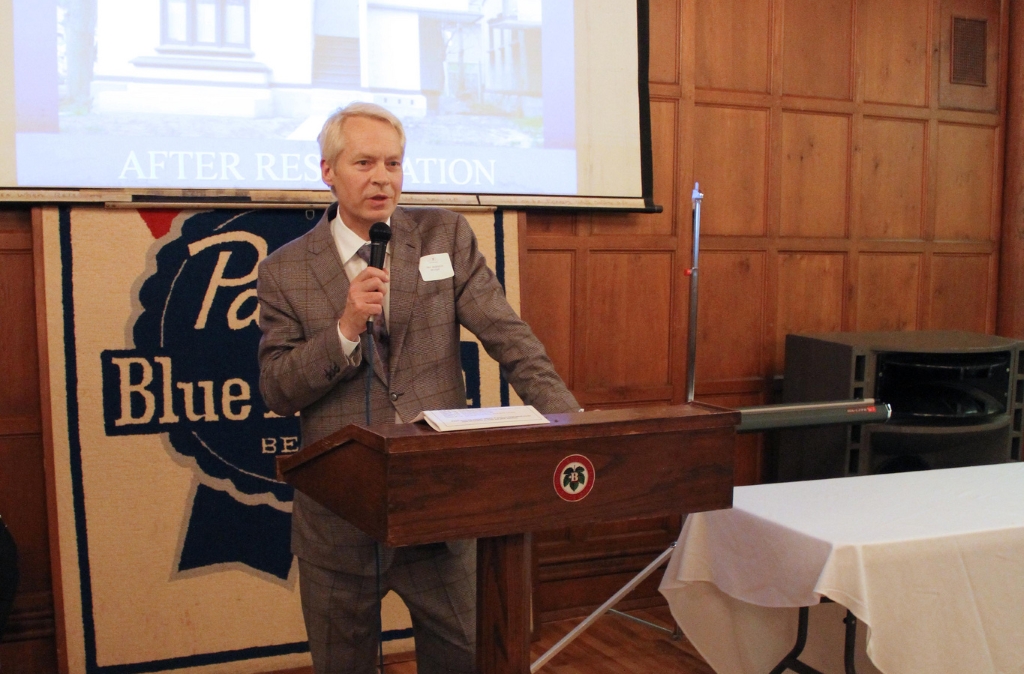
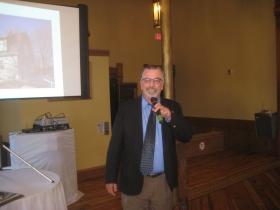
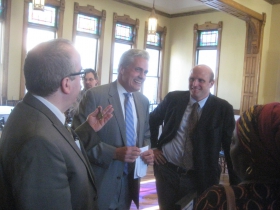
![Keith Stachowiak [l] Keith Stachowiak [l]](https://urbanmilwaukee.com/wp-content/gallery/the-brewery/thumbs/thumbs_img_7241.jpg)
